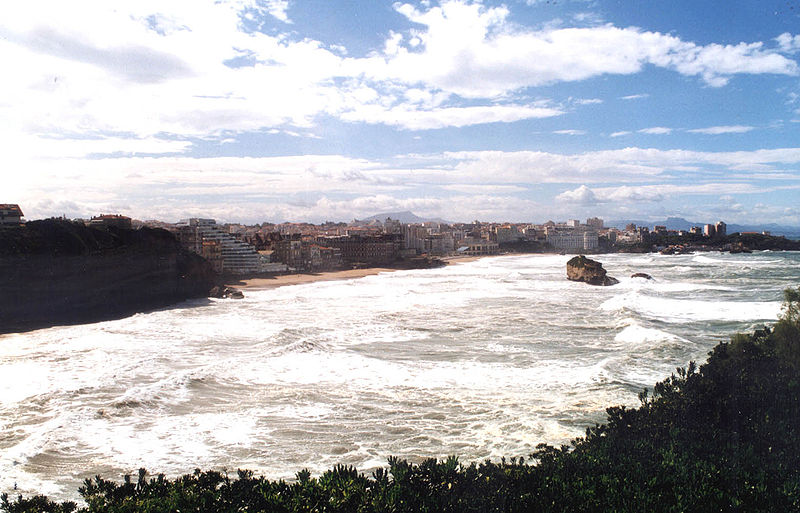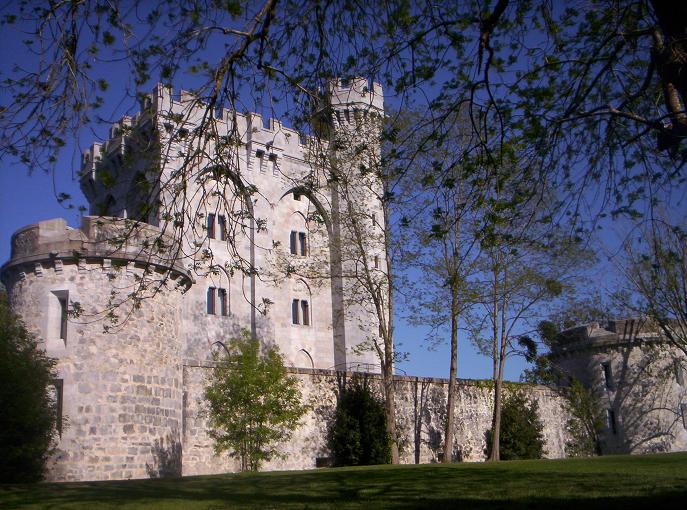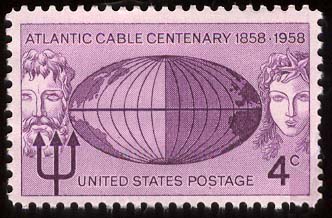|
Louis-Auguste Couvrechef
Louis Auguste Léodar Couvrechef (1827–1858) was a French architect who served Napoleon III as architect for the imperial residences. Early life Louis Auguste Léodar Couvrechef was born in Mathieu, Calvados, in 1827. Education He studied at the École des Beaux-Arts in Paris. Career Couvrechef was made a sub-inspector under architect Hippolyte Durand on the project to build the Villa Eugénie in Biarritz as a summer residence for the imperial family, starting in 1854. Durand chose a rather austere design, and was abruptly dismissed in June 1855. Couvrechef, who was known to prefer a more decorative style, was given responsibility for continuing the work. In 1857 Couvrechef became architect of the Château de Pau. Couvrechef was also involved in reconstruction of the Empress's Castillo de Arteaga in the province of Biscay in Spain, a medieval building surrounded by walls with four round towers. Death Couvrechef died in 1858 and was replaced as architect of the impe ... [...More Info...] [...Related Items...] OR: [Wikipedia] [Google] [Baidu] |
Mathieu, Calvados
Mathieu () is a commune in the Calvados department in the Normandy region in northwestern France. Population See also *Communes of the Calvados department The following is a list of the 528 communes of the Calvados department of France. The communes cooperate in the following intercommunalities (as of 2020):Communes of Calvados (department) Calvados communes articles needing translation from French Wikipedia {{Calvados-geo-stub ... [...More Info...] [...Related Items...] OR: [Wikipedia] [Google] [Baidu] |
Villa Eugénie
A villa is a type of house that was originally an ancient Roman upper class country house. Since its origins in the Roman villa, the idea and function of a villa have evolved considerably. After the fall of the Roman Republic, villas became small farming compounds, which were increasingly fortified in Late Antiquity, sometimes transferred to the Church for reuse as a monastery. Then they gradually re-evolved through the Middle Ages into elegant upper-class country homes. In the Early Modern period, any comfortable detached house with a garden near a city or town was likely to be described as a villa; most survivals have now been engulfed by suburbia. In modern parlance, "villa" can refer to various types and sizes of residences, ranging from the suburban semi-detached double villa to, in some countries, especially around the Mediterranean, residences of above average size in the countryside. Roman Roman villas included: * the ''villa urbana'', a suburban or country seat t ... [...More Info...] [...Related Items...] OR: [Wikipedia] [Google] [Baidu] |
Napoleon III
Napoleon III (Charles Louis Napoléon Bonaparte; 20 April 18089 January 1873) was the first President of France (as Louis-Napoléon Bonaparte) from 1848 to 1852 and the last monarch of France as Emperor of the French from 1852 to 1870. A nephew of Napoleon I, he was the last monarch to rule over France. Elected to the presidency of the Second Republic in 1848, he seized power by force in 1851, when he could not constitutionally be reelected; he later proclaimed himself Emperor of the French. He founded the Second Empire, reigning until the defeat of the French Army and his capture by Prussia and its allies at the Battle of Sedan in 1870. Napoleon III was a popular monarch who oversaw the modernization of the French economy and filled Paris with new boulevards and parks. He expanded the French overseas empire, made the French merchant navy the second largest in the world, and engaged in the Second Italian War of Independence as well as the disastrous Franco-Prussian War, ... [...More Info...] [...Related Items...] OR: [Wikipedia] [Google] [Baidu] |
École Nationale Supérieure Des Beaux-Arts
The Beaux-Arts de Paris is a French '' grande école'' whose primary mission is to provide high-level arts education and training. This is classical and historical School of Fine Arts in France. The art school, which is part of the Paris Sciences et Lettres University, is located on two sites: Saint-Germain-des-Prés in Paris, and Saint-Ouen. The Parisian institution is made up of a complex of buildings located at 14 rue Bonaparte, between the quai Malaquais and the rue Bonaparte. This is in the heart of Saint-Germain-des-Prés, just across the Seine from the Louvre museum. The school was founded in 1648 by Charles Le Brun as the famed French academy ''Académie de peinture et de sculpture''. In 1793, at the height of the French Revolution, the institutes were suppressed. However, in 1817, following the Bourbon Restoration, it was revived under a changed name after merging with the Académie d'architecture. Held under the King's tutelage until 1863, an imperial decree on No ... [...More Info...] [...Related Items...] OR: [Wikipedia] [Google] [Baidu] |
Hippolyte Durand
Hippolyte Durand (1801–1882 ) was a French architect who specialized in medieval-style church architecture. He restored or built many church buildings, mostly in the southwest of the country. He is perhaps best known for the Basilica of Our Lady of the Immaculate Conception at Lourdes, completed in 1872. Early years Hippolyte Durand was born in Paris in 1801. He attended the École des Beaux-Arts in Paris, where he was a student of Vaudoyer and Lebas. He won a departmental prize in 1829 and a medal in 1830. He became a specialist in medieval architecture. Durand worked on restoration of the Basilica of Saint-Remi in Reims, submitting a monograph on the subject to the Salon in 1837. He also submitted papers to the Salon on Notre-Dame de l'Épine near Châlons-sur-Marne (1838) and the church of Saint-Menoux in the Bourbonnais (1841). In 1842 Durand began to build the neo-classical theater of Moulins. During the years that followed he laid out various projects for constructio ... [...More Info...] [...Related Items...] OR: [Wikipedia] [Google] [Baidu] |
Biarritz
Biarritz ( , , , ; Basque also ; oc, Biàrritz ) is a city on the Bay of Biscay, on the Atlantic coast in the Pyrénées-Atlantiques department in the French Basque Country in southwestern France. It is located from the border with Spain. It is a luxurious seaside tourist destination known for the Hôtel du Palais (originally built for the Empress Eugénie circa 1855), its casinos in front of the sea and its surfing culture. Geography Biarritz is located in the Pyrénées-Atlantiques department in the Nouvelle-Aquitaine region. It is part of the arrondissement of Bayonne. It is adjacent to Bayonne and Anglet and from the border with Spain. It is in the traditional province of Labourd in the French Basque Country. Gallery File:Édouard_Zier_-_Les_baigneuses_à_Biarritz.jpg, ''Les baigneuses à Biarritz'', by Édouard François Zier File:Biarritz1999.jpg, Biarritz from the Pointe Saint-Martin. File:Grande Plage de Biarritz.jpg, ''La Grande Plage'', the town ... [...More Info...] [...Related Items...] OR: [Wikipedia] [Google] [Baidu] |
Château De Pau
The Château de Pau ( en, Pau Castle, eu, Paueko gaztelua) is a castle in the centre of the city of Pau, the capital of Pyrénées-Atlantiques and Béarn. It dominates that quarter of the city. Henry IV of France and Navarre was born here on December 13, 1553, and it was once used by Napoleon as a holiday home during his period of power. The château has been classified as a '' Monument historique'' since 1840 by the French Ministry of Culture. Nowadays, as the Musée national du Château de Pau, it contains a collection of tapestries. History Origins Pau Castle was founded in the Middle Ages. First and foremost a military structure, it is a typical fortified castle built on top of the hill overlooking the Gave bounded by the Hédas ravine. Since its construction, the castle has taken on a symbolic importance: possessing a stockade of piles (''pau'', in Béarnese), it designates, by metonymy, the city itself. These piles, symbolizing loyalty and righteousness, are each l ... [...More Info...] [...Related Items...] OR: [Wikipedia] [Google] [Baidu] |
Castillo De Arteaga
The Castillo de la Emperatriz Eugenia de Montijo ( eu, Eugenia de Montijo enperatrizaren gaztelua) is a neo-Gothic castle in the village of Arteaga, near Bilbao in the Basque Country of Spain. It is designated a Basque Heritage building. Location The castle is located in a fertile part of the Urdaibai estuary, not far from the historic town of Guernica. Unlike Spanish castles built for defense, it is not in an elevated position but on a plain or meadow, surrounded by trees and other vegetation. In this respect it resembles Fontainebleau Castle and other French royal residences. History The original manor house was said to have been built in the eighth century by Fortún Ortúnez and Sancho Gaúteguiz, and was destroyed and rebuilt many times. The castle was built on the foundations of a tower mentioned in writings from the mid-fifteenth century. By the nineteenth century it was very run down, having been used as a farmhouse. The tower was owned by the Arteaga family, who were ... [...More Info...] [...Related Items...] OR: [Wikipedia] [Google] [Baidu] |
Biscay
Biscay (; eu, Bizkaia ; es, Vizcaya ) is a province of Spain and a historical territory of the Basque Country, heir of the ancient Lordship of Biscay, lying on the south shore of the eponymous bay. The capital and largest city is Bilbao. Biscay is one of the most renowned and prosperous provinces of Spain, historically a major trading hub in the Atlantic Ocean since medieval times and, later on, one of the largest industrial and financial centers of the Iberian peninsula. Since the extensive deindustrialization that took place throughout the 1970s, the economy has come to rely more on the services sector. Etymology It is accepted in linguistics ( Koldo Mitxelena, etc.) that ''Bizkaia'' is a cognate of ''bizkar'' (cf. Biscarrosse in Aquitaine), with both place-name variants well attested in the whole Basque Country and out meaning 'low ridge' or 'prominence' (''Iheldo bizchaya'' attested in 1141 for the Monte Igueldo in San Sebastián). Denominations ''Bizkaia'' ... [...More Info...] [...Related Items...] OR: [Wikipedia] [Google] [Baidu] |
Gabriel-Auguste Ancelet
Gabriel-Auguste Ancelet (21 December 1829 – 3 August 1895) was a French architect who undertook various projects for the Emperor Napoleon III, and later taught for many years at the École des Beaux-Arts in Paris. Birth and education Gabriel-Auguste Ancelet was born in Paris on 21 December 1829. In 1845 he entered the studio of the architects Lequeux and Victor Baltard. From 1846 to 1851 he studied at the École des Beaux-Arts. In 1848 he won a prize for his drawing of "a fountain for Algeria". He won the Grand Prix de Rome for architecture in 1851 on the subject of "a hospice in the Alps". Ancelet was a scholar resident at the Villa Medici between 1852 and 1855. In 1853 he drew a "Restoration of the decor of the porch of Macellum in Pompeii", making great efforts to accurately reproduce both the form and the colors of this unusual interior decoration. He drew reconstructions of the Appian Way, a military road built in 312 BC between Rome and Capua, drawing on the ... [...More Info...] [...Related Items...] OR: [Wikipedia] [Google] [Baidu] |
1827 Births
Eighteen or 18 may refer to: * 18 (number), the natural number following 17 and preceding 19 * one of the years 18 BC, AD 18, 1918, 2018 Film, television and entertainment * ''18'' (film), a 1993 Taiwanese experimental film based on the short story ''God's Dice'' * ''Eighteen'' (film), a 2005 Canadian dramatic feature film * 18 (British Board of Film Classification), a film rating in the United Kingdom, also used in Ireland by the Irish Film Classification Office * 18 (''Dragon Ball''), a character in the ''Dragon Ball'' franchise * "Eighteen", a 2006 episode of the animated television series '' 12 oz. Mouse'' Music Albums * ''18'' (Moby album), 2002 * ''18'' (Nana Kitade album), 2005 * '' 18...'', 2009 debut album by G.E.M. Songs * "18" (5 Seconds of Summer song), from their 2014 eponymous debut album * "18" (One Direction song), from their 2014 studio album ''Four'' * "18", by Anarbor from their 2013 studio album ''Burnout'' * "I'm Eighteen", by Alice Cooper comm ... [...More Info...] [...Related Items...] OR: [Wikipedia] [Google] [Baidu] |
1858 Deaths
Events January–March * January – ** Benito Juárez (1806–1872) becomes Liberal President of Mexico. At the same time, conservatives install Félix María Zuloaga (1813–1898) as president. ** William I of Prussia becomes regent for his brother, Frederick William IV, who had suffered a stroke. * January 9 ** British forces finally defeat Rajab Ali Khan of Chittagong ** Anson Jones, the last president of the Republic of Texas, commits suicide. * January 14 – Orsini affair: Felice Orsini and his accomplices fail to assassinate Napoleon III in Paris, but their bombs kill eight and wound 142 people. Because of the involvement of French émigrés living in Britain, there is a brief anti-British feeling in France, but the emperor refuses to support it. * January 25 – The '' Wedding March'' by Felix Mendelssohn becomes a popular wedding recessional, after it is played on this day at the marriage of Queen Victoria's daughter Victoria, Princess Roy ... [...More Info...] [...Related Items...] OR: [Wikipedia] [Google] [Baidu] |



